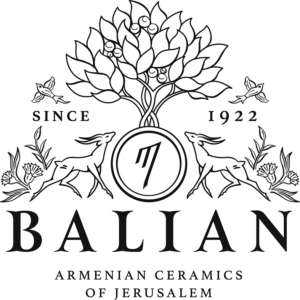GARDENS MADE IN JERUSALEM FAMILY TILE TRADITION RISES TO REALM OF ART
Jane Friedman
June 18, 1992
Since the early part of this century, on a winding street not far from the imposing walls of Jerusalem’s Old City, a family of Armenian potters has been turning out gracefully painted bowls, plates and tiles from an obscure atelier, continuing a Middle Eastern art form that began in Persia in the 13th century In recent years, western visitors to the Middle East — journalists and diplomats especially — became avid fans of Palestinian Pottery, descending on the atelier and returning to the United States with the firm’s decorated bowls and tiles. The objects became collectors’ items among people who frequented the Near East.
Now, the work of one family member, Marie Balian, 67, has been elevated to the status of fine art. In “Views of Paradise,” an exhibit in the International Gallery at the Smithsonian’s S. Dillon Ripley Center, her glazed wall panels — arranged around a glistening Arabian fountain — have received international recognition. It’s the largest space ever devoted to contemporary Middle Eastern art at the Smithsonian.
Balian’s work, like most art from the Arab world, is decorative. Because Islam bans depictions of humans, traditional art forms — like painting and sculpture for example — have long been eschewed. But applied art, like ceramic painting, has been a long tradition.
The show comes, oddly enough, at a time when Balian’s children are becoming known in the Washington area for their work on kitchens and baths. In the late 1980s, Balian’s son and daughter, operating out of a studio in Springfield, began to sell hand-painted tiles with Middle Eastern motifs for kitchens and bathrooms. The works of Marie Balian offer a “view of paradise” compared with the more earthbound work of her children.
“The children are artisans,” says Gus Van Beek, the Museum of Natural History curator who organized the show. “I regard Marie Balian as an artist. We have never seen a tile painter equal to her.”
The show brings together 22 wall panels that Balian did during the late 1980s and early ’90s. They depict lush gardens, swirling with garlands, flowers, gazelles, peacocks and birds and frequently framed by an arch to give the feeling of a view from a window. The panels give an idea of how a room is transformed when such tiled scenes are set into a wall, the way they are in the Middle East.
Balian’s work combines both Armenian and Islamic elements, drawing on traditions rooted in Persia, now Iran, and Turkey going back to medieval times.
“It’s very easy for me,” said Balian, speaking of her art while sitting in front of her panels at the Smithsonian. “It’s as if I did this in an earlier age.”
Balian’s family, as far back as she knows, had been potters in the town of Kutahya, Turkey. In the 13th century, Persians fleeing invaders from Central Asia streamed west into central Turkey, infusing life into a local ceramics tradition.
In 1919, a branch of the Balian family came to Jerusalem, commissioned by the Ottoman rulers to repair the 15th-century mosaic tiles on the Mosque of Omar. The mosque, which dominates the ancient Temple Mount, had been damaged during an earthquake.
The money for the project never materialized, but the Balians stayed on in the Holy Land, dissuaded from returning home because of the massacre of Armenians by the Turks. In 1922, they set up shop in East Jerusalem. Eventually, Setrak, the eldest son, began to churn out bowls and urns.
Painted decoration was simple until Setrak, on a visit to France, met Marie, a distant cousin whose family also hailed from Kutahya. She had been studying fine art in France. After they married, Marie Balian set about applying her vision of Eden to the bowls and plates produced in Jerusalem.
Then, in 1967, the world changed. As a result of the Six Day War, Jerusalem was unified and diplomats, academics, and journalists based in Israeli West Jerusalem now discovered Palestinian Pottery in the eastern half of town. In 1969, Van Beek, conducting an archaeological dig near the Gaza Strip, also discovered it. From then on, he and his wife would visit the Balians each summer, encouraging Marie Balian to do more of the large panels that she had begun to experiment with.
By 1990, she had done major commissions including wall panels for the salon at Israel’s presidential residence. Once there was a body of work, Van Beek began to lobby the Smithsonian for a show. The exhibition has been extended three months and will likely travel afterward.
The artisan tiles of Balian’s children, Sylva and Neshan, charmed Tammy Haddad, senior executive producer for “Larry King Live,” who is a Syrian-American. Haddad noticed the tiles at a kitchen boutique and hired the younger Balians to do the kitchen in the Palisades home she and her husband bought.
“I thought they were beautiful,” she said of the tiles. “They’re not like other grapes or vines. They were so beautifully detailed.”
The Balian’s company, The Ceramic Tile Studion in Alexandria, Va , sells the artisan tiles through several kitchen and bath showrooms in the Washington area.
Because of the strife in Jerusalem between Jews and Arabs, Marie Balian hopes to work part of the year in the Washington area. She says the local foliage will not change her Middle Eastern view of paradise which, she says, is firmly etched in her mind.





